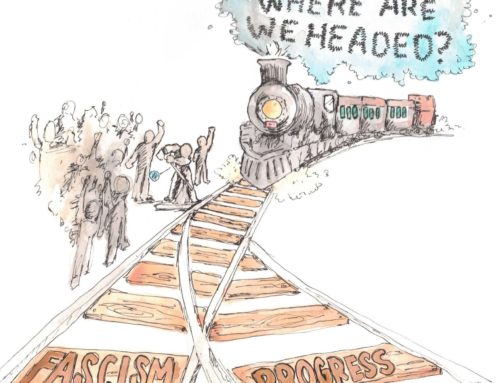An Insider Exposes Garment Industry Practices
by Designer X
With barely a year or so under my belt as a clothing designer, after graduating from one of the most famous Fashion Design universities in the world, I said something like this to my dad: “Dad, I feel guilty. I’ve learned since graduation that the people making the stuff we design get paid very little and live in squalor.” Dad reassured me, “They’re just happy to have a job.” That soothed my conscience at the time, but lately I’ve wondered: Are they really?
My eyes have been opened about the industry in which I work. There is so much wrong with it, from start to finish. This is because it, like every industry, is subject to the laws of the overall economic system of capitalism in which it functions. The owners rake in profits, while everyone else suffers.
Owners in the clothing industry ride Rolls Royces to work, while their sewers have to walk, or cram three or four people onto one broken-down old scooter. I know because I saw them parking while I worked there. Owners justify owning sprawling mansions and a fleet of the best luxury cars, eating in the finest, trendiest restaurants, while the laborers (who are making the owners rich enough to afford those lavish lifestyles) go home to tin- or tar- covered makeshift shacks— if they get to go home at all (and not back to cramped dormitories with no privacy whatsoever). I was even told once that at a factory in India that we were using had workers with bare feet. They could not afford shoes. I know because I worked for the company that contracted from them. How does this happen? Workers are never paid the full value of their work. Surplus value is syphoned off into the wallets, pockets and foreign bank accounts of the owners, or to the board of directors if the company is publicly traded on the stock market.
Haitian garment workers make 2 cents per minute to sew garments. That’s an average of $1.20 per hour. The next country up is Brazil at 5 cents per minute. In much of Asia, the textile workers’ salaries are about the same. If Haitian textile workers all walked off the job demanding at least 5 cents per minute at the same time that Brazilian workers walked off demanding 8 cents per minute, they could start a general hemispherical strike that would force the capitalists to give in because they’d have nowhere else to go.
The globe is viewed as two separate pieces for capitalists in the garment industry. They look at Asia as one option, and Central/South America/ the Caribbean as their other option. But usually they like to utilize both, rather than choosing between one or the other. They ping pong with their business from one country to the next, pitting nation against nation for jobs at a pitiful pittance.
But if production was disrupted in one hemisphere all at once, there would be no quick fix. The apparel industry is run on very long, year-long supply chain timeline planning calendars. Usually six months at a time are locked in, in advance. If you mess with them for at least four weeks it hurts them. 10 weeks off the job would hurt them very badly. VERY, VERY badly.
There’s no quick fix for them AT ALL. There are no means of production, no machinery in the United States anymore. They don’t turn ships around quickly. With their global neoliberal agenda, they pay overseas workers starvation, sweatshop wages. But workers, if they are organized, could turn the tables on them. You would be surprised how many big companies have all of their eggs in one basket, in one factory, or in one country (or two countries max). They are not agile. Not like you would think. It would take them 12 weeks, at least, to change factories—so they could be held over the ropes for up to 10-11 weeks.
Why should people, workers, starve and not have anything of their own to show for themselves but the belongings that can fit into a backpack, while the woman or man taking away all the surplus value (which the hungry, desperate workers create) live in sprawling mansions on beach front property, with two summer houses, summers abroad and two maids? What did the owners do to deserve all that? They perform no more work hours, and no more sweat falls from their brows, than any worker who cuts, sews, presses or folds the goods. That is something that I can verify.
29 cents per shirt. That’s how much they pay in the Dominican Republic for the labor it takes to make a typical shirt, not unlike the one you are probably wearing right now. In Haiti labor costs only one third that amount. Can I really believe that people are happy to earn 10 cents per shirt?
Highly paid managers bully the workers who get a measly $1.20 per hour. Here’s just one example. Like Brittany Spears used to say, I’m not that innocent (myself). I had been given a bit of a warning of how the system works when I was studying fashion, but I didn’t think it was industry-wide. I didn’t think I had to be a part of it, even though I wanted to be a design employee of a company, and have a job doing my trade. (Actually it’s not even called Fashion Design any more. It’s mostly called Product Development). One day during my brief one semester as an Apparel Production Management Major, the professor giddily reminisced in class, “Let me tell you a story of something I did managing a factory several years ago.” (He was referring to a time before credit cards were common.) “The sewers were leaving, the turnover rates of employees was quick, so I came up with a way to get people to stay.” (Read: as virtually indentured servants). “The workers needed major home appliances such as refrigerators, stoves and the like.” (Read: we don’t pay them enough to afford these on their own). “So we got each employee the major appliance for their home that they were lacking, and told them they couldn’t leave the job until they paid off that debt.” You could assume that was a long time, since historically apparel production laborers don’t get paid much.
Now I know it is industry-wide and global. Twisting people’s arms is par for the course in a race to the bottom, to drive down the cost price for apparel to the lowest possible amount. Every season, every clothing company you have ever heard of or worn yourself, bids lowball amounts for the cheapest priced goods that they can get their greedy hands on.
The salaries of apparel designers are also losing ground. As of 2012, in the most expensive zip code in the U.S., the average apparel designer with five or more years of on-the-job experience (plus a degree) earns about $53,500 annually. In the 1980s, I’m told that experienced designers earned an average of about $70,000 per year. I’m not talking about famous designers, but about regular employees of the design companies. Even a job that cannot be outsourced easily, yet, isn’t keeping up with inflation. On the contrary. This is the failure of capitalism for everyone who works for a living.
So it may look cool to study fashion design because of shows like “Project Runway,” but to know you are situated at the higher levels of a system that degrades the majority of its workers, providing them only with a barely subsistent living, at nearly slave labor—that you are contributing to a system that offers the poorest salaries in the world in manufacturing, outsourced to desperate developing countries racing to the bottom—would you be able to just be happy to have that job? The terrible conditions are not limited to overseas workers. Here in the USA, many distribution warehouses have no heating, ventilation or air conditioning. Even in South Florida. One warehouse worker in Hialeah told me: “It’s hot in the summer and cold in the winter.”
Another cold thing that South Florida apparel company owners are doing is forcing all of their sewers and finishers to pay self-employment taxes, even though they are full time workers–they falsely call their labor force “independent contractors” and subject them to, essentially, double social security and Medicare payroll taxes while owners pocket the additional profits for themselves.
Monsanto’s Genetically Modified Cotton, Farmers’ Suicides, and Your Torn Jeans
Capitalists are always trying to cheat other capitalists. They call it competition. The ways overseas factory owners try to cheat the American manufacturers are numerous. One example comes to mind. In recent years the cotton crops failed in India several times, due to Monsanto’s experimentation with a seed that didn’t grow well, even though they convinced farmers to bet all they had on it. When the Monsanto cotton crops failed twice, desperate and demoralized farmers started taking their own lives, some by drinking the very chemicals Monsanto sold them as fertilizer. Then with a cotton shortage, mills could not meet the demand for fabric. So they started using waste cotton mixed with the virgin cotton. Cotton mixed with waste cotton rips, tears and falls apart easily. So not only did Monsanto destroy the lives of innocent, hard-working farmers, but they destroyed your jeans as well.
Live to work or work to live? Or live at work, 24 hours a day, sleeping in crowded bunk beds. In Asia, especially in China, the people who sew our clothing live at their jobs in cramped dormitories. They are only free to leave once per year for two weeks, during Chinese New Year when the factories close.
Your tank tops float in the tanker ship for weeks, because they’re not made here anymore. It’s the exact opposite of “buy local.” Imagine the carbon footprint of a shirt made thousands of miles away from where you buy it.
One time a boss, an owner, said in my presence: “Minimum wage is so expensive.” US federal minimum wage was $6.55 at the time. I didn’t have the spine to say to her what I was thinking: “Who could live on that?!” I was speechless, because I was sickened and shocked. My boss was thinking globally though. She had to have been comparing the US minimum wage to the minimum wage in Haiti. Or Brazil, which is $2,500 per year. I guess compared to that, $15,000 per year is considered “expensive.” This is why an international minimum wage is so critical. Garment manufacturers think of the whole world as their playground for profiting off of the proletariat (people who work for a paycheck, in other words employees verses employers).
PROFIT PROFIT PROFIT, but not for the proletariat. Bangladesh and Haiti have the lowest paid workers in the garment industry, in the world. As an activist from Bangladesh recently noted, “All the employers and world banks are totally against a national minimum wage. Because according to them, this will take investors out and this will have a really bad effect on development and investment. So that will squeeze job creation, and all these bullshit theories.” The capitalists are against the minimum wage in Haiti and Bangladesh because they are making such a HUGE profit off of the workers. Obscene amounts of surplus value is stolen from the laborers. They won’t negotiate a compromise unless they have to. In both countries, the garment workers are paid 2 cents per minute. Each shirt takes a total of 10 minutes to make. Instead of charging 20 cents for the shirt, the US manufacturer is earning thousands of percent profit on each item, and the U.S. government is taking billions in duty tariffs to allow the garments/clothes/products to be imported into this country, and stores/retailers are again making large profits off of imported goods.
This sick and greedy supply chain from hell does nothing to create more than a very small, token number of American jobs (like quality control manager or accountant). Even the customer service representatives that take the orders for clothing (if sold through a catalog or online), are based in overseas call centers. Even with duty rates of up to 40% of cost price, the owners (called manufacturers in the United States, even though they as corporations don’t actually manufacture anything; many don’t even own any of the machines, or means of production themselves, but contract out the work as “full package” or full imports from overseas), are charging a 65% profit margin or markup above the cost price. In other words, owners are making millions or billions, while the workers overseas are making pennies. Why is this OK? Is it OK? Are they just happy to have a job?






Great day! I could have sworn I have been to this weblog before but following checking through a few of the publish I realized it is new to me. Anyhow, I am definitely happy I found it and I will be book-marking and checking back often!